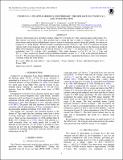| dc.contributor.author | McCollough, M. L. | |
| dc.contributor.author | Dunham, M. M. | |
| dc.contributor.author | Corrales, Lia | |
| dc.date.accessioned | 2017-05-12T15:05:50Z | |
| dc.date.available | 2017-05-12T15:05:50Z | |
| dc.date.issued | 2016-10 | |
| dc.identifier.issn | 2041-8213 | |
| dc.identifier.uri | http://hdl.handle.net/1721.1/109041 | |
| dc.description.abstract | Chandra observations have revealed a feature within 16'' of Cygnus X-3 that varied in phase with Cygnus X-3. This feature was shown to be a Bok globule that is along the line of sight to Cygnus X-3. We report on observations made with the Submillimeter Array to search for molecular emission from this globule, also known as Cygnus X-3's "Little Friend." We have found a counterpart in both [superscript 12]CO (2-1) and [superscript 13]CO (2-1) emission. From the velocity shift of the molecular lines we are able to find two probable distances based on the Bayesian model of Milky Way kinematics of Reid et al. For the LF velocity of −47.5 km s[superscript −1], we find distances of 6.1 ± 0.6 kpc (62% probability) and 7.8 ± 0.6 kpc (38% probability). This yields distances to Cyg X-3 of 7.4 ± 1.1 kpc and 10.2 ± 1.2 kpc, respectively. Based on the probabilities entailed, we take 7.4 ± 1.1 kpc as the preferred distance to Cyg X-3. We also report the discovery of bipolar molecular outflow, suggesting that there is active star formation occurring within the Little Friend. | en_US |
| dc.language.iso | en_US | |
| dc.publisher | IOP Publishing | en_US |
| dc.relation.isversionof | http://dx.doi.org/10.3847/2041-8205/830/2/L36 | en_US |
| dc.rights | Article is made available in accordance with the publisher's policy and may be subject to US copyright law. Please refer to the publisher's site for terms of use. | en_US |
| dc.source | American Astronomical Society | en_US |
| dc.title | CYGNUS X-3: ITS LITTLE FRIEND’S COUNTERPART, THE DISTANCE TO CYGNUS X-3, AND OUTFLOWS/JETS | en_US |
| dc.type | Article | en_US |
| dc.identifier.citation | McCollough, M. L., L. Corrales, and M. M. Dunham. “CYGNUS X-3: ITS LITTLE FRIEND’S COUNTERPART, THE DISTANCE TO CYGNUS X-3, AND OUTFLOWS/JETS.” The Astrophysical Journal 830.2 (2016): L36. © 2016The American Astronomical Society | en_US |
| dc.contributor.department | MIT Kavli Institute for Astrophysics and Space Research | en_US |
| dc.contributor.mitauthor | Corrales, Lia | |
| dc.relation.journal | The Astrophysical Journal | en_US |
| dc.eprint.version | Final published version | en_US |
| dc.type.uri | http://purl.org/eprint/type/JournalArticle | en_US |
| eprint.status | http://purl.org/eprint/status/PeerReviewed | en_US |
| dspace.orderedauthors | McCollough, M. L.; Corrales, L.; Dunham, M. M. | en_US |
| dspace.embargo.terms | N | en_US |
| mit.license | PUBLISHER_POLICY | en_US |
